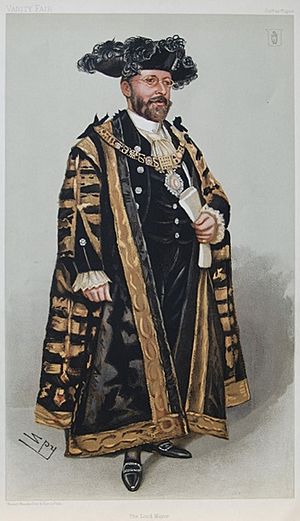Joseph Dimsdale facts for kids
Sir Joseph Cockfield Dimsdale, 1st Baronet, KCVO, PC (born January 19, 1849 – died August 9, 1912) was an important person in London. He served as the Lord Mayor of London in 1902, which was the year King Edward VII was crowned. He was also a Member of Parliament (MP) for the City of London from 1900 to 1906. An MP is someone elected to represent a specific area in the country's main law-making body.
Contents
Early Life and Education
Joseph Cockfield Dimsdale was born in Cornhill, London, on January 19, 1849. He was the oldest son of Joseph Cockfield Dimsdale. He went to a famous school called Eton. His family had a long history in Essex and belonged to the Quaker religious group. He was also related to a well-known doctor and politician named Thomas Dimsdale.
A Career in London's Government
Sir Joseph Dimsdale had a very active career in London. He was a successful banker, working as the Managing Director of Prescott, Dimsdale and Co. He was also a key member of the Grocers' Company, which is one of London's old and important trade groups called Livery Companies. He even led the company for a time.
Roles in the City of London
Dimsdale held several important positions in the City of London:
- He was an Alderman for Cornhill from 1891 to 1902. An Alderman is a senior member of a city council.
- He was chosen as Sheriff of London in 1893. The Sheriffs help the Lord Mayor with their duties.
- In September 1901, he became the Lord Mayor of London. He held this top position from November 1901 to November 1902.
Serving as a Member of Parliament
In the 1900 general election, Dimsdale was elected as a Member of Parliament (MP) for the City of London. He served in this role until 1906. As an MP, he helped make laws and represent the people of London in the national government.
Honors and Special Events
Sir Joseph received many honors during his career:
- He was made a Knight in 1894. This honor was given to him when Tower Bridge was opened and a new heir to the throne was born, while he was Sheriff.
- In 1902, during King Edward VII's Coronation, Dimsdale had a special role. He carried the Crystal Sceptre of the City of London in front of the King.
- He was given the title of Baronet on July 24, 1902. A Baronet is a hereditary title, meaning it can be passed down in the family.
- Later that year, on October 24, 1902, the King made him a Knight Commander of the Royal Victorian Order (KCVO). This is a special honor given by the monarch.
International Visitors and Diplomatic Gifts
During his time as Lord Mayor, Dimsdale welcomed important guests from other countries:
- In June 1902, he met Prince Komatsu Akihito of Japan. The Prince was visiting for the King's coronation. Dimsdale received the 2nd class of the Japanese Order of the Rising Sun honor.
- He also welcomed Ras Makonnen, a special envoy from the Emperor of Ethiopia. After Makonnen left, Dimsdale received the 2nd class of the Order of the Star of Ethiopia. The City of London also received gifts like a silver shield and a sword.
Visits to English Cities
As Lord Mayor, Dimsdale also traveled to other cities in England:
- In July 1902, he visited Wolverhampton. He was given the honorary freedom of the borough, which is a special honor. Many other mayors attended this ceremony.
- In September of that year, he visited Bath and Exeter with the Sheriffs.
Other Activities and Later Life
Dimsdale was also involved in other groups. He was a senior member of the Freemasons of England, which is a social and charitable organization. He was also an active member of the Primrose League, a political group.
Sir Joseph Dimsdale passed away on August 9, 1912. At the time of his death, he was serving as the Chamberlain of the City of London. He had held this position since November 1902. A portrait of him, showing him in his Lord Mayor robes and holding the crystal scepter, was revealed in October 1902.
Family Life
In 1873, Joseph Dimsdale married Beatrice Eliza Bower Holdsworth. They had three children together. Their oldest son, John Holdsworth Dimsdale (1874-1923), later became the 2nd Baronet after his father.


